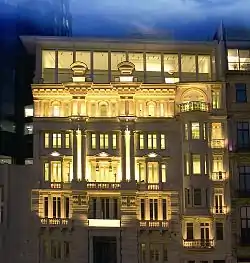İstiklal Avenue
İstiklal Avenue (Turkish: İstiklal Caddesi; English: Independence Avenue), historically known as the Grand Avenue of Pera (Ottoman Turkish: جادهٔ كبیر, romanized: Cadde-i Kebir; Greek: Μεγάλη Οδός του Πέραν, romanized: Megali Odos tou Peran; French: Grande Rue de Péra), in the historic Beyoğlu (Pera) district, is an 1.4 kilometre (0.87 mi) pedestrian street and one of the most famous avenues in Istanbul, Turkey. It acquired its modern name after the declaration of the Republic on 29 October 1923, İstiklal (Independence) commemorating Turkey's triumph in its War of Independence.
| Grand Avenue of Pera | |
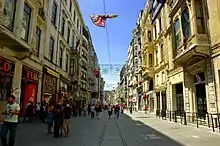 | |
 Shown within Turkey | |
| Type | Street |
|---|---|
| Location | Beyoğlu, Istanbul Province, Turkey |
| Coordinates | 41°02′03.0″N 28°58′44.0″E |
The street starts at the northern end of Galata (the medieval Genoese quarter) at Tünel Square and runs as far as Taksim Square. It is flanked by late Ottoman era buildings (mostly from the 19th and early 20th centuries) in a variety of styles including Neo-Classical, Neo-Gothic, Renaissance Revival, Beaux-Arts, Art Nouveau and First Turkish National Architecture. There are also a few Art Deco style buildings from the early years of the Turkish Republic, and a number of more recent examples of modern architecture. Many would once have been apartment blocks but most are now occupied by boutiques, music stores, art galleries, cinemas, theatres, libraries, cafés, pubs, nightclubs with live music, hotels, historical patisseries, chocolateries, restaurants and a steadily growing number of international chain stores. There is even a branch of Madame Tussauds.

Galatasaray Square marks the middle of the avenue and is home to the oldest secondary school in Turkey: the Galatasaray High School (Galatasaray Lisesi), originally known as the Galata Sarayı Enderun-u Hümayunu (Galata Palace Imperial School). A monument, these days fenced off as a police post, commemorates the fiftieth anniversary of the founding of the Turkish Republic in 1973.
The avenue forms a spine with narrow side streets running off it like a ribcage. Many historical and politically significant buildings can be found on or immediately adjacent to Istiklal Avenue. They include the Çiçek Pasajı (Flower Passage) which is full of lively restaurants and taverns; the Balık Pazarı (The Fish Market) with the Armenian church of Üç Horan to one side; the Hüseyin Ağa Mosque; the Roman Catholic churches of Santa Maria Draperis and S. Antonio di Padova; the Greek Orthodox church of Hagia Triada; several academic institutions established by Austria, France, Germany and Italy in the 19th century; and the consulates (embassies until 1923 when these moved to the new capital of Ankara) of France, Greece, the Netherlands, Russia, Spain and Sweden (the consulate of the United Kingdom is just off Istiklal Avenue on Meşrutiyet Street).

At the southern end of the avenue, it is possible to board the Tünel (the Tunnel), the world's second-oldest subway, which entered service in 1875 and carries passengers down to Karaköy. A photogenic red-and-cream tram runs along the street from Tünel to Taksim Square every 15 minutes.
History
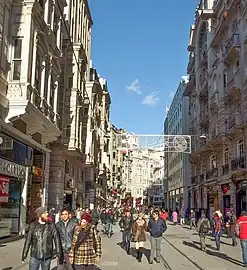
During the Ottoman period, the avenue was called Cadde-i Kebir (Grand Avenue) in Turkish or the Grande Rue de Péra in French. It was a popular gathering place where Ottoman intellectual rubbed shoulders with Europeans and the local Italian and French Levantines. When 19th-century travelers referred to Constantinople (today Istanbul) as the Paris of the East, they were usually thinking of the Grande Rue de Péra and its cosmopolitan, half-European, half-Asian culture.
On 6–7 September 1955 an anti-Greek Istanbul pogrom resulted in many shops along the avenue being pillaged; its pavements were covered with broken glass, scattered clothing, smashed white goods, burned automobiles and other items that had belonged to the Greek owners of the wrecked shops.[1]
Between the 1950s and 1970s the side streets around the Emek Pasajı were home to Yeşilcam, Turkey's home-grown equivalent of Hollywood, a fact commemorated in the street name Yeşilcam Sokağı.
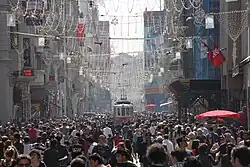
The avenue fell from grace in the 1970s and 1980s as the old Istanbulite inhabitants moving elsewhere, and the side streets (then infamous for bars and night clubs with live music and shows, called pavyon in Turkish) were repopulated by migrants from rural Anatolia.
During the late 1980s and early 1990s, a revival took place, spearheaded and executed by the Istanbul Metropolitan Municipality and Beyoğlu Municipality. Historic buildings were restored, the street was pedestrianised, and the old historic trams were reinstated, bringing back much of the avenue's old charm and popularity. İstiklal Avenue became the center for fine arts and leisure in Istanbul once again and real estate prices skyrocketed. Numerous new art galleries, bookstores, cafés, pubs, restaurants, shops and hotels were opened in and around the street, and venues around it became the host to many international art festivals, such as the annual Istanbul Film Festival.
Until the mid-2010s, İstiklal Avenue was also a popular venue for all sorts of events such as the Istanbul Pride and International Women's Day parades). Marches, gatherings and protests took place there virtually every day. However, after the Gezi Park protests of 2013 all such gatherings were effectively banned.
On 19 March 2016, an Islamic State suicide bombing on Istiklal Avenue killed five people.[2][3][4]
On 13 November 2022, a bomb explosion on Istiklal Avenue killed 6 people and left 81 injured.[5] Police detained a Syrian woman, Ahlam Albashir, suspected of being a Kurdish insurgent having planted the bomb, in a sweep of 47 arrests.[6]
Notable buildings

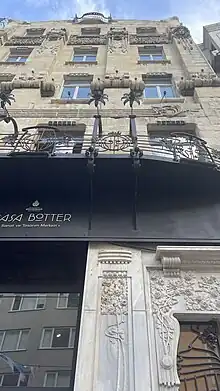
- Religious buildings
- Church of Sant'Antonio di Padova
- Hagia Triada Greek Orthodox Church
- Church of Santa Maria Draperis
- Hüseyin Ağa Mosque
- Schools
- Historic buildings and residences
- Old Galatasaray Post Office
- Rumeli Pasajı (Cité Roumelie)
- Hazzopulo Pasajı
- Mısır Apartments
- Casa Botter, one of the finest examples of Art Nouveau architecture in Istanbul
- Grand Pera, home in the past to the Cercle d'Orient and now to Madame Tussauds Istanbul
- Tokatliyan Han, once home to the Grand Tokatliyan Hotel
- Food and drink
- Çiçek Pasajı (Cité de Péra), site of the Naum Theatre until 1870
- Lebon Patisserie & Café, a defunct historic pastry shop and café
- Markiz Pastanesi, a renowned historic pâtisserie and chocolaterie
- Narmanlı Han, originally home to the Russian Embassy, later home to artist Aliye Berger, today houses cafés and restaurants
- Diplomatic missions
- Dutch Consulate
- French Consulate
- Greek Consulate
- Russian Consulate
- Swedish Consulate
- Culture and arts
References
- Binnaz Tugba Sasanlar. A Historical Panorama of an Istanbul Neighborhood: Cihangir from the Late Nineteenth Century to the 2000s Archived 2012-12-10 at the Wayback Machine Bogaziçi University. 2006
- "Istanbul shopping area hit by suicide bomber". BBC. 19 March 2016.
- "Istanbul explosion: Suicide bomber had ISIS links, says Turkey's interior minister". CNN. 20 March 2016. Archived from the original on 18 August 2016. Retrieved 25 July 2016.
- "Istanbul explosion: At least five dead as tourist shopping area Istiklal Street hit by suicide bombing in Turkey". The Independent. 19 March 2016. Archived from the original on 2 May 2019. Retrieved 4 December 2017.
- "Turkey: Several killed and wounded after explosion hits Istanbul's busy Istiklal street". Middle East Eye. Retrieved 2022-11-13.
- "Woman Who Planted Bomb In Istanbul That Killed 6 People Arrested By Turkish Police".
